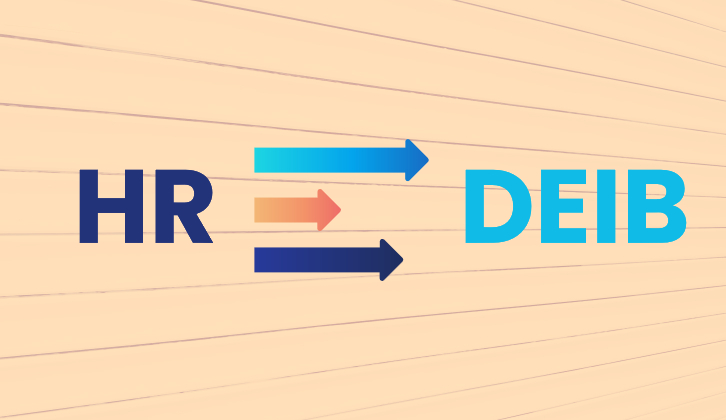I’ve been working in the field of diversity, equity, inclusion and belonging inside corporations for 20 years now. For the majority of that time, I was part of the HR organization. The only exceptions were when I was an external consultant, but even then, the clients that hired me were usually inside HR.
The work of DEIB has evolved significantly since I started in this space. It used to be seen as primarily the responsibility of HR, but over time, that viewpoint has expanded. Now, there is advocating for DEIB to be a broader C-suite responsibility and, as a result, taken out of HR as a function.
My perspective is that DEIB is the responsibility of everyone at the company and that we cannot dismiss the critical role HR plays in our ability to drive progress and change. In fact, HR can be the organization’s best champion in advocating for DEIB if we enable them with the right mindset and capabilities to do so.
So how do we empower HR professionals to own and drive DEIB initiatives? Here are three key steps to get started.
Get educated
All HR professionals should take the opportunity to learn about the issues contributing to a lack of diversity, equity and inclusion in society. We should all be students of history and do our best to understand what is important to different communities and what systemic barriers may be holding them back from equitable experiences.
The closer we can get to the issues and the people they affect, the more likely we are to be motivated to do something about it. And the more educated we are about the issues, the more confident we will be in addressing them. I try to pilot diversity education programs within HR first to give them the tools they need to influence business leaders across the organization as well.
Gather employee voice
We have to understand how different employees have different experiences within our organizations, so it’s important to have multiple channels for gathering the voices of your employees.
This can mean tapping into your analytics functions to help you deep-dive into demographic data, conducting regular employee surveys on how they experience DEI at the company, and talking directly to employees about the different talent practices within your company to determine whether any particular communities are being underserved by them.
Creating out-of-the-box opportunities for employees to tell you what they need can be particularly energizing as well. One example is “Hack-the-Culture” events, where employees ideate solutions around workplace needs in a fast-paced, 48-hour team competition.
Redesign systems
Once you’re armed with knowledge of the issues and what your employees are experiencing, then you’ve got to start applying it in a systematic way.
For example, hiring is an end-to-end talent process that needs to be rethought in many companies. This is an opportunity to reimagine and disrupt legacy hiring practices and apply fresh thinking to how we define job criteria, who we decide to interview, what questions we ask and who gets to decide.
This is how companies have thought to remove college degree or criminal conviction requirements from certain roles that don’t actually need them, thus increasing the diversity of the talent pool they can draw from. You can apply similar thinking toward promotion, leadership development and succession planning. HR professionals can assess each of these processes for systematic bias and design interventions to encourage more equitable outcomes for all.
And all of this has to be done with a spirit of innovation. We in HR have got to do things differently than what we’ve done in the past otherwise we’ll never make progress in the diversity and inclusion of our organizations. What’s been done to date hasn’t changed the status quo. So we’ve got to experiment, be willing to put our foot in our mouth and fail, but also learn from those failures and keep going.
Inaction or actions that make us feel better but don’t actually do anything meaningful are no longer acceptable. Employees, customers and shareholders are smarter than that and demanding more.
If C-suite leaders truly believe that people are their most valuable asset, it’s ironic that HR is notorious for being under-resourced. The best HR people I know share the same goals as DEIB — to help every employee contribute their best selves at work and fulfill their potential.
It’s time for all of us to recognize that we can’t make progress in DEIB without an empowered HR function supporting it. HR professionals are crucial to the equation in making change real and sustainable across all of a company’s talent processes.
Cynthia Owyoung is the author of “All Are Welcome: How to Build a Real Workplace Culture of Inclusion that Delivers Results.” Owyoung is Robinhood’s vice president of inclusion, equity and belonging, partnering with business leaders, employee resource groups and the people experience team to support Robinhood’s mission to democratize finance for all. She’s also the founder of Breaking Glass Forums, where she develops strategies to accelerate more diverse leaders and inclusive organizations.
A recognized diversity leader, Owyoung was named to Entrepreneur Magazine’s 100 Women of Impact in 2021. Owyoung serves on the board of directors for AbilityPath, a nonprofit dedicated to empowering people with special needs to achieve their full potential.
If you liked this article, sign up for SmartBrief’s free email newsletters on HR and leadership. They’re among SmartBrief’s more than 250 industry-focused newsletters.
